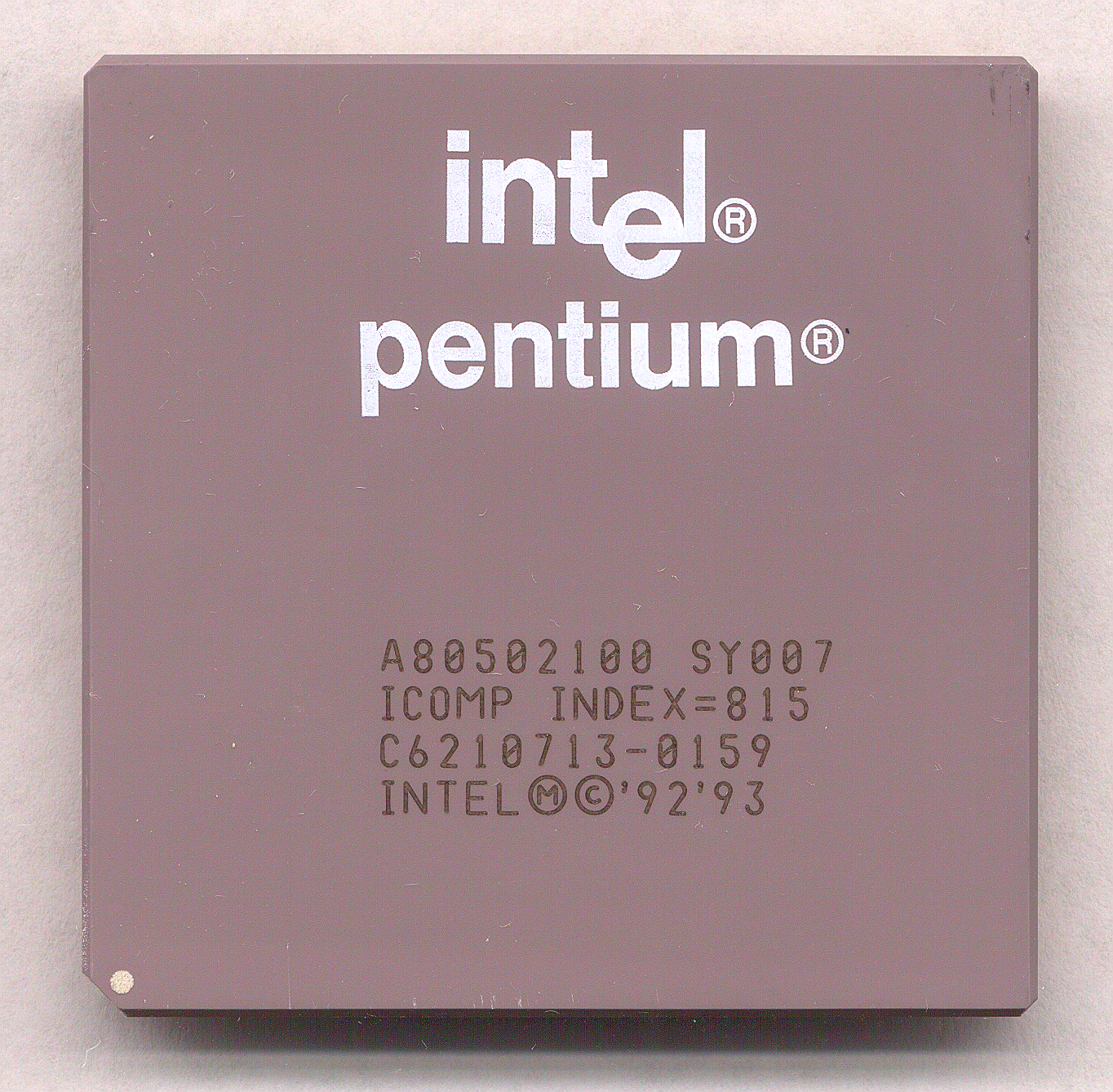|
Timeline Of Intel
This is a timeline of Intel, one of the world's largest semiconductor chip makers. Timeline References {{Technology company timelines Intel Intel Corporation is an American multinational corporation and technology company headquartered in Santa Clara, California. It is the world's largest semiconductor chip manufacturer by revenue, and is one of the developers of the x86 seri ... Intel ... [...More Info...] [...Related Items...] OR: [Wikipedia] [Google] [Baidu] |
Intel
Intel Corporation is an American multinational corporation and technology company headquartered in Santa Clara, California. It is the world's largest semiconductor chip manufacturer by revenue, and is one of the developers of the x86 series of instruction sets, the instruction sets found in most personal computers (PCs). Incorporated in Delaware, Intel ranked No. 45 in the 2020 ''Fortune'' 500 list of the largest United States corporations by total revenue for nearly a decade, from 2007 to 2016 fiscal years. Intel supplies microprocessors for computer system manufacturers such as Acer, Lenovo, HP, and Dell. Intel also manufactures motherboard chipsets, network interface controllers and integrated circuits, flash memory, graphics chips, embedded processors and other devices related to communications and computing. Intel (''int''egrated and ''el''ectronics) was founded on July 18, 1968, by semiconductor pioneers Gordon Moore (of Moore's law) and Robert Noyce ( ... [...More Info...] [...Related Items...] OR: [Wikipedia] [Google] [Baidu] |
CHMOS
CHMOS refers to one of a series of Intel CMOS processes developed from their HMOS process. (H stands for high-density). It was first developed in 1981. CHMOS was used in the Intel 80C51BH, a new version of their standard MCS-51 microcontroller. The chip was also used in later versions of Intel 8086, and the 80C88, which were fully static version of the Intel 8088. The Intel 80386 was made in 1.5 µm CHMOS III, and later in 1.0 µm CHMOS IV. CHMOS III used 1.5 micron lithography, p-well processing, n-well processing, and two layers of metal. CHMOS III-E used for the 12.5 MHz Intel 80C186 microprocessor.Ormsby, John, Editor, "New Product Focus: Components: It's Under Control With The 80C186", Intel Corporation, Microcomputer Solutions, November/December 1987, page 13 CHMOS IV (H stands for High Speed) used 1.0 µm lithography. Many versions of the Intel 80486 The Intel 486, officially named i486 and also known as 80486, is a microprocessor. It is a higher-p ... [...More Info...] [...Related Items...] OR: [Wikipedia] [Google] [Baidu] |
Public Relations
Public relations (PR) is the practice of managing and disseminating information from an individual or an organization (such as a business, government agency, or a nonprofit organization) to the public in order to influence their perception. Public relations and publicity differ in that PR is controlled internally, whereas publicity is not controlled and contributed by external parties. Public relations may include an organization or individual gaining exposure to their audiences using topics of public interest and news items that do not require direct payment. The exposure mostly is media-based. This differentiates it from advertising as a form of marketing communications. Public relations aims to create or obtain coverage for clients for free, also known as earned media, rather than paying for marketing or advertising also known as paid media. But in the early 21st century, advertising is also a part of broader PR activities. An example of good public relations would be ge ... [...More Info...] [...Related Items...] OR: [Wikipedia] [Google] [Baidu] |
Pentium
Pentium is a brand used for a series of x86 architecture-compatible microprocessors produced by Intel. The original Pentium processor from which the brand took its name was first released on March 22, 1993. After that, the Pentium II and Pentium III were released. In their form , Pentium processors are considered entry-level products that Intel rates as "two stars", meaning that they are above the low-end Atom and Celeron series, but below the faster Intel Core lineup, and workstation/server Xeon series. , Pentium processors have little more than their name in common with earlier Pentiums, which were Intel's flagship processor for over a decade until the introduction of the Intel Core line in 2006. They are based on both the architecture used in Atom and that of Core processors. In the case of Atom architectures, Pentiums are the highest performance implementations of the architecture. Pentium processors with Core architectures prior to 2017 were distinguished from the fast ... [...More Info...] [...Related Items...] OR: [Wikipedia] [Google] [Baidu] |
Semiconductor
A semiconductor is a material which has an electrical resistivity and conductivity, electrical conductivity value falling between that of a electrical conductor, conductor, such as copper, and an insulator (electricity), insulator, such as glass. Its electrical resistivity and conductivity, resistivity falls as its temperature rises; metals behave in the opposite way. Its conducting properties may be altered in useful ways by introducing impurities ("doping (semiconductor), doping") into the crystal structure. When two differently doped regions exist in the same crystal, a semiconductor junction is created. The behavior of charge carriers, which include electrons, ions, and electron holes, at these junctions is the basis of diodes, transistors, and most modern electronics. Some examples of semiconductors are silicon, germanium, gallium arsenide, and elements near the so-called "metalloid staircase" on the periodic table. After silicon, gallium arsenide is the second-most common s ... [...More Info...] [...Related Items...] OR: [Wikipedia] [Google] [Baidu] |
Intel Inside
Intel Corporation is an American multinational corporation and technology company headquartered in Santa Clara, California. It is the world's largest semiconductor chip manufacturer by revenue, and is one of the developers of the x86 series of instruction sets, the instruction sets found in most personal computers (PCs). Incorporated in Delaware, Intel ranked No. 45 in the 2020 ''Fortune'' 500 list of the largest United States corporations by total revenue for nearly a decade, from 2007 to 2016 fiscal years. Intel supplies microprocessors for computer system manufacturers such as Acer, Lenovo, HP, and Dell. Intel also manufactures motherboard chipsets, network interface controllers and integrated circuits, flash memory, graphics chips, embedded processors and other devices related to communications and computing. Intel (''int''egrated and ''el''ectronics) was founded on July 18, 1968, by semiconductor pioneers Gordon Moore (of Moore's law) and Robert Noyce (1927–1990) ... [...More Info...] [...Related Items...] OR: [Wikipedia] [Google] [Baidu] |
RISC
In computer engineering, a reduced instruction set computer (RISC) is a computer designed to simplify the individual instructions given to the computer to accomplish tasks. Compared to the instructions given to a complex instruction set computer (CISC), a RISC computer might require more instructions (more code) in order to accomplish a task because the individual instructions are written in simpler code. The goal is to offset the need to process more instructions by increasing the speed of each instruction, in particular by implementing an instruction pipeline, which may be simpler given simpler instructions. The key operational concept of the RISC computer is that each instruction performs only one function (e.g. copy a value from memory to a register). The RISC computer usually has many (16 or 32) high-speed, general-purpose registers with a load/store architecture in which the code for the register-register instructions (for performing arithmetic and tests) are separate fr ... [...More Info...] [...Related Items...] OR: [Wikipedia] [Google] [Baidu] |
Complex Instruction Set Computing
A complex instruction set computer (CISC ) is a computer architecture in which single instructions can execute several low-level operations (such as a load from memory, an arithmetic operation, and a memory store) or are capable of multi-step operations or addressing modes within single instructions. The term was retroactively coined in contrast to reduced instruction set computer (RISC) and has therefore become something of an umbrella term for everything that is not RISC, where the typical differentiating characteristic is that most RISC designs use uniform instruction length for almost all instructions, and employ strictly separate load and store instructions. Examples of CISC architectures include complex mainframe computers to simplistic microcontrollers where memory load and store operations are not separated from arithmetic instructions. Specific instruction set architectures that have been retroactively labeled CISC are System/360 through z/Architecture, the PDP-11 and V ... [...More Info...] [...Related Items...] OR: [Wikipedia] [Google] [Baidu] |
80486
The Intel 486, officially named i486 and also known as 80486, is a microprocessor. It is a higher-performance follow-up to the Intel 386. The i486 was introduced in 1989. It represents the fourth generation of binary compatible CPUs following the Intel 8086, 8086 of 1978, the Intel 80286 of 1982, and 1985's i386. It was the first tightly-instruction pipeline, pipelined x86 design as well as the first x86 chip to include more than one million transistors. It offered a large on-chip Cache (computing), cache and an integrated floating-point unit. A typical 50 MHz i486 executes around 40 million instructions per second (MIPS), reaching 50 MIPS peak performance. It is approximately twice as fast as the i386 or i286 per Clock signal, clock cycle. The i486's improved performance is thanks to its five-stage pipeline with all stages bound to a single cycle. The enhanced FPU unit on the chip was significantly faster than the i387 FPU per cycle. The intel 80387 FPU ("i387") ... [...More Info...] [...Related Items...] OR: [Wikipedia] [Google] [Baidu] |
Deskpro
The Compaq Deskpro is a line of business-oriented personal computers manufactured by Compaq, then discontinued after the merger with Hewlett-Packard. Models were produced containing microprocessors from the 8086 up to the x86-based Intel Pentium 4. History Deskpro (8086) and Deskpro 286 The original Compaq Deskpro (released in 1984), available in several disk configurations, is an XT-class PC equipped with an 8 MHz 8086 CPU and Compaq's unique display hardware that combined Color Graphics Adapter graphics with high resolution Monochrome Display Adapter text. As a result, it was considerably faster than the original IBM PC, the XT and the AT, and had a much better quality text display compared to IBM PCs which were equipped with either the IBM Monochrome Display Adapter or Color Graphics Adapter cards. Its hardware and BIOS were claimed to be 100% compatible with the IBM PC, like the earlier Compaq Portable. This compatibility had given Compaq the lead over companies ... [...More Info...] [...Related Items...] OR: [Wikipedia] [Google] [Baidu] |





.jpg)

